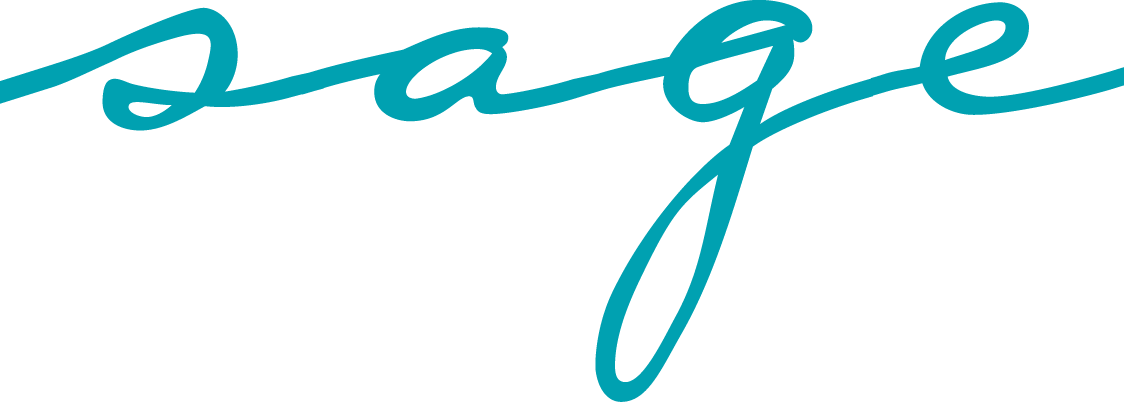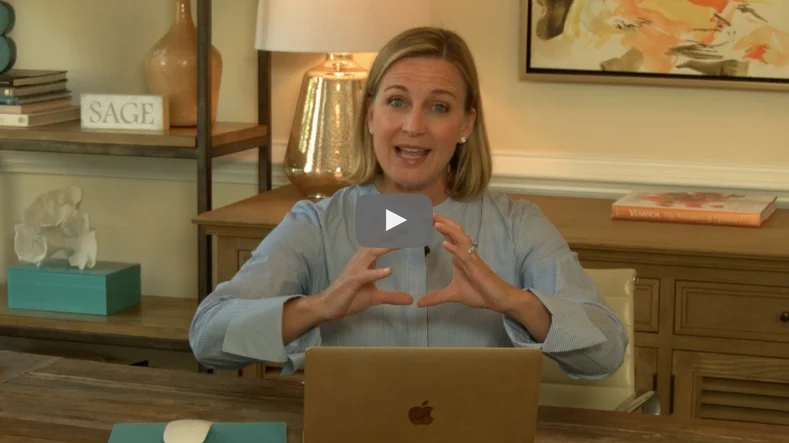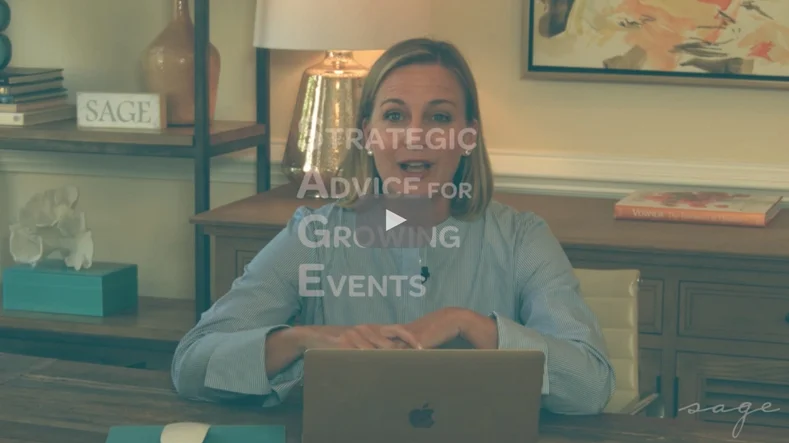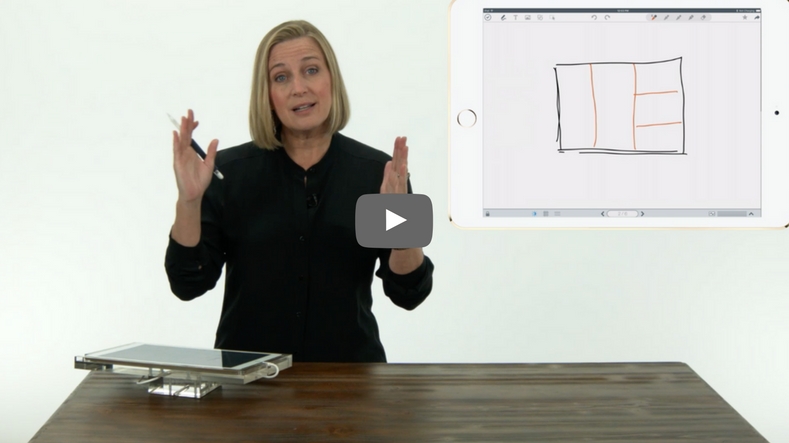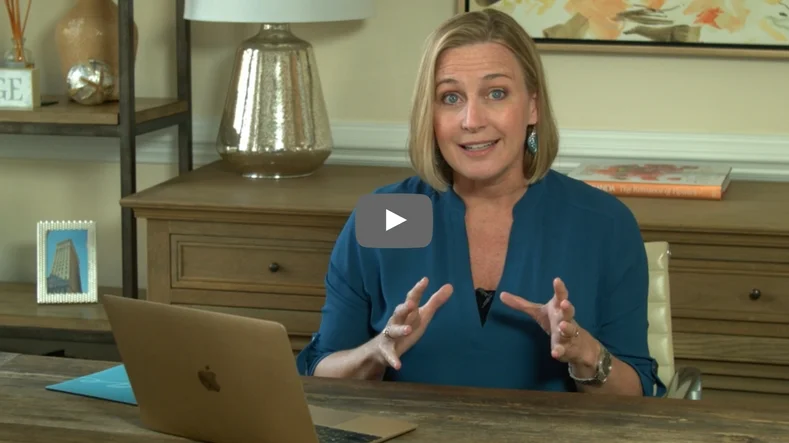The Event Is the Offer: Designing the Flow of Your Live Event
Hi there. I'm Bari Baumgardner, founder of SAGE Event Management. Today I want to talk to you about something that often pops up in our conversations with new clients as we build out their program: it’s the overarching design of a live event.
First, however, I want to give you a quick snapshot of something you may not know. You may have been watching our videos, and you may have heard of SAGE. But do you know what SAGE actually stands for? SAGE stands for Strategic Advice for Growing Events.
Growing Your Live Event with Strategic Advice
Fourteen years ago when I started the company, I was thinking really hard about what space I wanted to claim in the marketplace. It was really obvious to me that I didn't want to be just another event production company. I knew that great site selection, contract negotiation, and seamless logistics were really important. I knew that people needed amazing event support so that they could focus on being their best possible selves as hosts - and so that their attendees could have an incredible experience.
But even more than that, I thought it was super important that people receive strategic advice for growing their events. Growing events doesn’t just mean the size. Not all of our clients are trying to become a 5,000-person event. In some cases, growing events means growing the revenue, growing the space in the market, and claiming visibility. This concept of growing your presence with strategic advice has always been at the heart of what we do at SAGE Event Management.
SAGE Starts with a Strategy First Day
When we begin working together with a client, one of the things that we typically do is to kick off our relationship with a Strategy First Day. It’s basically four to six hours of time together to plan out a concrete strategy.
Some people in our industry refer to this as a VIP Day. But in the SAGE world, we call it a Strategy First Day - and that’s because we believe that strategy must always come first. Right from the start, we want to be crystal clear about what you're trying to accomplish with your live event. Once that is determined, then we can reverse engineer it in order to guarantee the results that you're looking for.
We always do a Strategy First Day, whether it’s for an existing client or a consulting client. For existing clients like Jeff Walker or Lisa Sasevich, we’ll actually be planning their live events for them. For consulting clients like Mary Morrissey or Sonia Stringer, they have their own in-house team. In that case, we're just giving them consulting advice strategy to increase the leverage at their events and improve the host and attendee experience.
More Than a Moment: Your Entire Live Event is the Offer
Universally what I find to be true - especially lately - is this big, big focus on the offer. Everyone wants to nail their offer. What is my offer? How can I improve my offer? But the idea that I really want to impose upon you is this: your whole event is the offer.
For many people, especially in the information marketing industry, there tends to be this offer moment that is ultimately the most critical time of the entire event. But the fact is: if your whole event is the offer, then the entire architecture of that three days matters as much as that one moment in time.
This is true no matter what. It’s true if you're a trade association and your offer is to invite members to renew. It’s true if your live event is designed to get a new product or service out onto the market. It’s true if you’re introducing a new mastermind or a group program.
It really doesn't matter what the offer is. Every live event should have some type of invitation for the audience to stay connected and to work in a deeper way with you. Live events are the most powerful platform for getting people to stay engaged.
Your Event is a Continuum with a Three-Day Energy Flow
Your three-day engagement in is part of a continuum. It's what happens before the event, during the event, and after the event. It's already part of a continuum - and you want to think of your three-day event as a continuum, too. It's not just this one moment in time when you make an offer, but rather a three-day energy flow. I really want you to think of it that way: a three-day energy flow.
Every day the flow is different. On the first day, the energy goes up and peaks. On the second day, we tend to see the energy come down a little bit. On the third day, we really want to finish strong and bring that energy back up again. Every day, the flow is predicated on what's happening in the room and how you design your event. It’s also a little bit of human nature.
Day One: Content and Connection
The first day is about content and connection, over and over and over again. We give great content. We give great connection. We give great content. We give great connection. Our goal at the end of Day One is to provide your attendees with such a fantastic experience that they would think the event was a success if they had to leave right then.
Guests have received so much amazing content and experienced such a great connection with you, with your team, with the other attendees - that they are already thinking, “job well done.” They’ve had tons of “aha” moments. The travel was totally worth it. They have notebooks filled with things they want to do when they get home. Each guest feels like if they had to leave after the first day, it was time and money well-spent.
But there are still two more days. People are super excited because it’s the end of day one and they’ve gotten everything they came for and then some - and there are still two more days to go! Day One’s flow is high energy. All that great content and creation has left people super excited. Then Day Two arrives, and the flow is more about the problem and solution.
Day Two: Problem and Solution
As you continue to provide amazing content and great connection, it all starts to stack on top of itself. All of those “aha” moments, all of those great takeaways, and all of those great notes start piling up. It stacks and stacks and stacks, until it becomes a little bit of a problem for the attendee - which leads to a dip in the energy on Day Two.
The problem is that people start to feel overwhelmed. They’ve had so many exciting “aha” moments that they don’t know what to do when they get home. They don’t know how to prioritize. For many attendees, this feeling of being overwhelmed can be a real negative, especially if you're selling a program or a product. So you have to overcome that negative feeling with a solution.
Feeling Overwhelmed: Energy Dips & Pain Sets In
The afternoon of Day Two is midway through the program of a three-day event, and that’s about the time when the feeling of being overwhelmed starts to settle in. It’s when the energy begins to dip because attendees start feeling concerned about what they’re going to do when they get home. They start feeling the pain.
Attendees know there’s only one day left. All of their excitement and elation has shifted to concerns about going back into the real world. People have to go back home and go back to the office, go back to the family, go back to the solo-preneurial way of life. Whatever issues were there when they left are going to be waiting for them when they get home. That's where the energy dip happens, and that’s when the pain sets in.
Present Your Solution - Your Offer - Right at the Point of Pain
But the great thing about that point of pain is that you have a solution. And your solution should be given at that exact point in the event’s program. Your solution is in the form of an offer. It’s an invitation to your guests. Listen: if you're feeling overwhelmed, if you're feeling the pain of disconnect, if you're feeling concerned about having to go home and not knowing exactly how to prioritize all the great information we've given to you, here is the solution.
If you’re a trade association, it might be membership. For an information marketer, it might be a mastermind program. But the invitation is to provide a solution so each attendee feels an enhanced sense of community, accountability, and opportunity.
But if you haven't done a great job of shaping the whole event, it doesn't matter how great the offer is. Really, the whole event is the offer. We want to hold attendees in that space and lead them into the next day, Day Three.
Day Three: Decision and Commitment
We want to leave each attendee on a high note and with a big upswell of energy, so Day Three is all about decision and commitment. Day One has been content and connection. In Day Two, that content and connection have led to a problem and its solution - to stay engaged. Day Three is about making a decision:
Making a decision to stay connected
Making a decision to buy the product
Making a decision to join the program
Making a decision to renew with the association or group
Making a decision is a commitment to stay engaged for the rest of the year, and that leads to the next upswell in energy. We’ve gone up on Day One. We've had the inherent overwhelm and down-swell that happens on Day Two. And now the energy has gone back up on Day Three, because with decision and commitment comes a sense of calm.
Only You Can Do the Work - But You Don’t Have to Do It Alone
There’s a sense of calm in knowing that only you can do the work - but you don't have to do it alone. That's really a key point with the SAGE Event Management, and we're always trying to communicate this information. Only you can do the work. There's no magic bullet. But you don't have to do it alone.
And that's why the offer exists for you. That’s why the program, that product, that service, that group program, that mastermind, that trade association exists. The point of pain is having to go it alone - and the solution is that you don't have to. But it will require decision and commitment to get there.
How to Design the Offer at Your Live Event
If you’re deciding how to design the offer at your next live event, I really want you to think about how to design the three days. How to design Day One to deliver content and connection, how to design Day Two for problem and solution, and how to design Day Three for decision and commitment.
Design your event so that you can bring your attendees through that energy flow. If you’re doing a one-day event, you can still use this same approach for the morning, midday, and afternoon/evening. The same energy flow happens at a one-day event that happens at a three-day event.
Empower Your Live Events with SAGE
I hope this has been helpful for you. If you're interested in learning more or you'd like to have a Strategy First Day with SAGE, all you have to do is reach out to us at events@poweredbysage. We'd love to help walk you through not only how to make your best offer, but how to make your best event. Go team, go!
Take your live event strategy to the next level with SAGE. Right now you can get access to three more FREE video tips. Learn how to monetize your live event before it begins, and take control of your business future.
